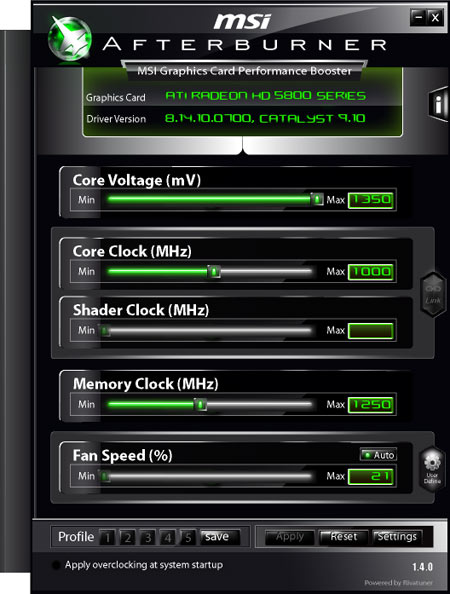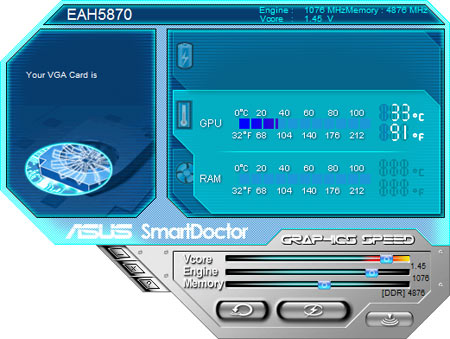PowerColor Radeon HD 5870 LCS: The GHz Limit, Broken
Overclocking PowerColor's Radeon HD 5870 LCS
There were many twists and turns on our PowerColor Radeon HD 5870 LCS overclocking journey. Let’s start with the fundamentals.
When it comes to Radeon graphics cards, each manufacturer imposes overclocking limits in its product's BIOS. Most overclocking tools will reference these limits to see what maximum core and memory overclock they will allow the user to set. There are some tools that can work around this limitation, but they have some drawbacks that we’ll talk about later.
The Radeon HD 5800-series has some serious overclocking potential because the GPU’s voltage can be modified on the fly, as long as you have the software tools to do this. With the right tools, overclockers can increase GPU voltage to achieve higher core clock rates, same as you'd do on a host processor plugged into your motherboard. We're looking for a maximum overclock, so this is obviously of interest to us.
There are a few tools out there for overclocking the Radeon HD 5870, the most commonly-used being ATI’s Overdrive utility built into the Catalyst Control Center. Unfortunately, Overdrive does not allow for voltage control and is limited by the BIOS-imposed restrictions, so overclockers seeking the highest performance will have to look elsewhere.
There are tools that will ignore the BIOS settings, including RivaTuner, AMD GPU Clock Tool, and ATITool. However, they have a significant disadvantage in that they don’t play nice with ATI’s PowerPlay feature, meaning that if you overclock using these tools, the card will run at full power all of the time. Using any of these to overclock, your Radeon HD 5870 will run hot and potentially draw hundreds of watts of power, even at idle. In addition, we’re not aware that any of these tools allow for substantial voltage increases. Because of these drawbacks, none of these tools provide a truly elegant solution in our eyes, so we looked for more options.
Asus offers an overclocking tool called “SmartDoctor” that allows for flexible voltage and clock settings, thus allowing the user to push the GPU voltage up to as high as 1.5V from the stock 1.16V. The problem with this utility is that it looks at your Radeon HD 5870’s BIOS to see if the card was made by Asus. If it wasn’t, it won’t work.
Perhaps the most compelling tool of note is the MSI Afterburner utility. Co-developed by MSI and the team that’s responsible for the venerable RivaTuner utility, it offers voltage increases up to 1.35V in addition to clock speed control, and even monitors vitals such as temperatures, fan speeds, and voltages. The real beauty of this tool is that it seems to be vendor-agnostic, allowing us to run it on our PowerColor Radeon HD 5870 LCS.
Get Tom's Hardware's best news and in-depth reviews, straight to your inbox.
BIOS Issues and Workarounds
So, all we have to do is take the MSI Afterburner utility, pump up the voltage to 1.35V, and push the card as fast as it will go, right? There is one slight problem: remember those overclocking limits coded in the BIOS that we mentioned earlier? Well, the PowerColor Radeon HD 5870 LCS in our lab has a top overclocking limit of 900 MHz core and 1,300 MHz memory. This is nothing short of pathetic for a liquid-cooled board with this card's potential. To clarify, this imposes a limit of 50 MHz over the reference core speed and 100 MHz over the reference memory speed.
We immediately contacted PowerColor and asked for a BIOS with higher overclock limits to accommodate this enthusiast card, citing other BIOS files available on the Web with much higher overclocking limits. We suggested something that would allow us to try 1,200 MHz core speeds.
PowerColor responded with a BIOS that does a bit better than the original, sporting a 1,000 MHz core and a 1,500 MHz memory limit. It might not offer the 1,200 MHz core limit we were hoping for, but it’s a step in the right direction. At the time this article was written, PowerColor told us future versions of the Radeon HD 5870 LCS will get this BIOS from the factory and customers with the original BIOS can contact the company directly for the upgraded version if they desire. Purportedly, there were about 100 boards shipped with the more limited software, so its effects should still be fairly minor.
One Card, Two Overclocks
We want to figure out how far we can go with this card, so we’re going to overclock it twice. First, we will see how the card does at PowerColor's 1,000 MHz core and 1,500 MHz memory limits.
Using the MSI Afterburner tool, we were able to push the card to 1,000 MHz core at the tool’s maximum 1.35V setting. The memory wouldn’t overclock at all without system instability and a reduction in performance, so it had to stay at the stock 1,250 MHz setting. Therefore, our first overclock was 1,000 MHz core and 1,250 MHz memory.
We originally intended to see how far the card could go, so we decided to up the ante by applying an unlocked Asus Radeon HD 5870 BIOS we came across. This Asus BIOS not only had the 1,200 MHz core limit we originally wanted from PowerColor, but it also allows us to use the SmartDoctor tool and its high 1.5V core voltage limit.
The downside to this, of course, is that flashing a non-stock BIOS will quickly void the warranty (at best) and perhaps damage the card (at worst). We’re taking the risk so you don’t have to, and you will be able to see if the danger is worth our results. Of course, we’re in no way advocating that flashing a graphics card is the smartest thing to do to a $520 add-in, and any damage you cause by trying it is obviously your own responsibility.
Using the SmartDoctor tool, we managed a maximum core speed of 1,076 MHz at 1.45V. More voltage didn’t give us any more headroom, even though our liquid-cooled temperatures were low. It looks like PowerColor’s 1,000 MHz limit might not be so bad after all. Even worse, at this high core speed, the memory caused some stuttering performance and we had to back it down to 1,219 MHz for stability, leaving us with a final core overclock of 1,076 MHz, but a memory underclock of 1,219 MHz. It is a real shame that none of these tools are able to offer us a memory voltage increase, but we did the best we could without soldering anything to the card (or frying an SMT component).
The benchmarks will show us if there is any significant advantage to using Asus' unlocked BIOS and SmartDoctor compared to the stock software that PowerColor ships (in unison with MSI's Afterburner tool).
Current page: Overclocking PowerColor's Radeon HD 5870 LCS
Prev Page Installation Next Page Test System And BenchmarksDon Woligroski was a former senior hardware editor for Tom's Hardware. He has covered a wide range of PC hardware topics, including CPUs, GPUs, system building, and emerging technologies.
-
CoryInJapan Wow...is ATI leading again...O wait they are.Reply
Nice to see ATI back on top. Would be nice to have that card. -
jimmysmitty Enjoy it while it lasts ATI.Reply
Unless nV screws G300 up (rebranding G200) then it may be a nice time but wont last forever.
If only they could get a damn seperate shader clock. With 1600 SPs running at 1.7GHz they could blow nV out of the water.... -
anamaniac It's dissapointing to hear the memory had to be put so low...Reply
Though I'd love to liquid cool my i7, then add a 5870 and liquid cool that also. I got a radiator at work that can likely handle a 10 kilowatt system, add to that it's constantly cooled by sub zero temperatures (during winter atleast), with a 5 barrel resevoir, and dual 24" fans (used to cool 3000psi hydraulics).
Even more dissapointing to see it can't keep up with it's dual 4xxx series cousin.
Also, GPU waterblocks just look so inneficient... -
7amood WOOOOOOOW extremely low temperatures... but not worth the 500W draw.Reply
I think now am interested in water cooled video cards.
but honestly, i thought the gain will be 20% at least... disappointing. -
liquidsnake718 You made a mistake on the test and benchmark page on the Crysis Bench config. It states you tested it at low quality. This would mean at least 100-150FPS....Reply
Nice work but I also wish you guys tested Crysis at Very High settings.... its always great to see Crysis tested at its maximum threshhold. -
shubham1401 Being a single card 5870 performs very impressively...Reply
And the power usage is impressive too(Only on stock).
This is the best card for now and with a lil price dip it'll be fav. of all high end gamers. -
IzzyCraft I love the draw on their oc 1 gpu is greater then 2 older gen gpus draw that's just hilariously bad results. Still with the waterblock set up maybe you can afford the 1000 dollar electric bill with you're fastest possible machine. Sorry but as far as ATI venders powercolor is low on the list of ones i trust. Poor 5870 gpu wasted on excess and ya can't waste those things, hard to come by with tsmc doing jack in the yields department.Reply

